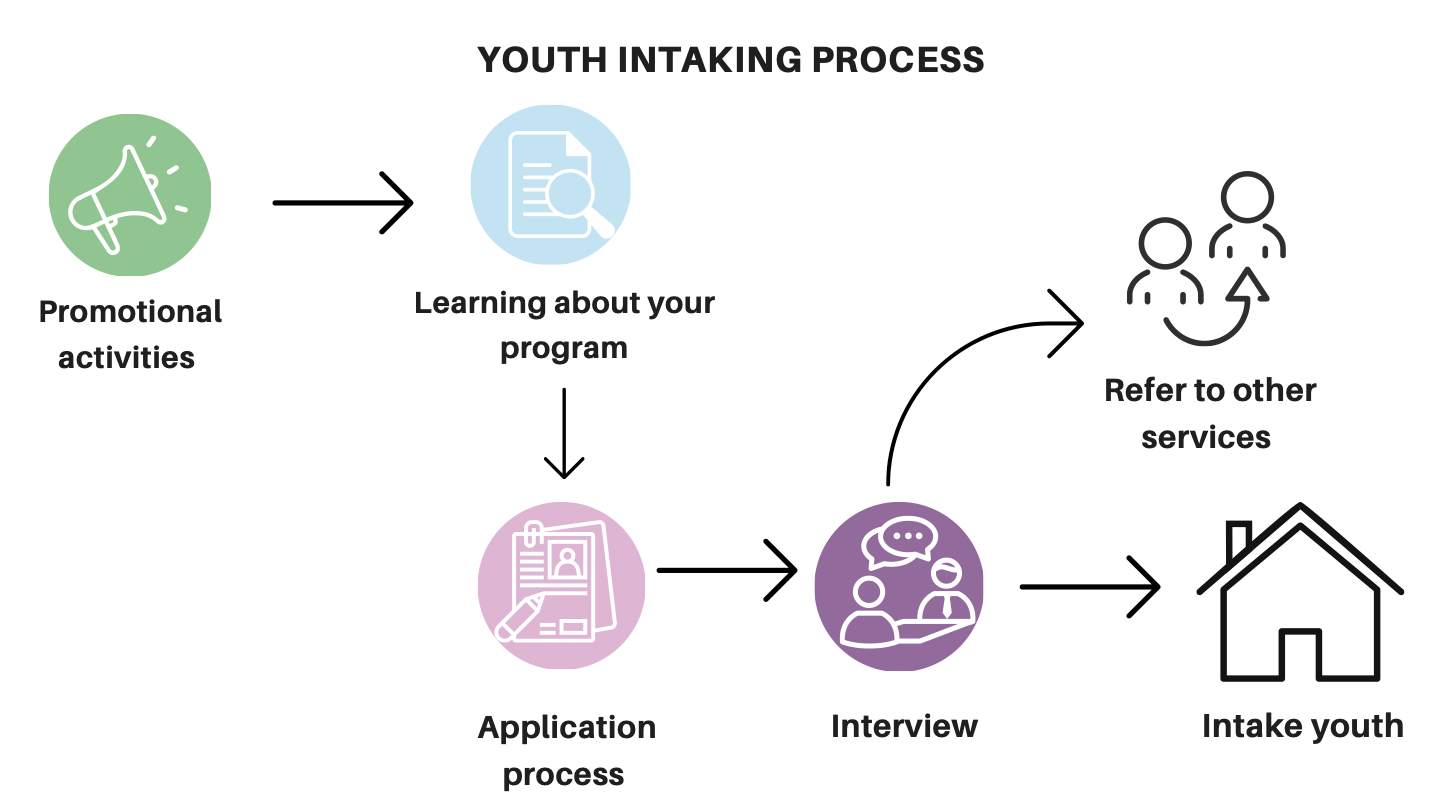
Reaching 2SLGBTQ+ Youth
- Prepare communication materials and distribute online, at relevant events and programs, and throughout media channels
- Talk about the program at local 2SLGBTQ+ events and youth-focused services
- Reach out to schools, housing agencies, and other youth agencies in order to share the program and invite referrals
Ensure that it is easy for youth and other support workers to connect with you. This includes clearly identifying contact information, the intake process, and requirements for living within the home. Sometimes it is necessary to use strategic methods to reach out to youth who are not online, homeless, living in other transitional housing, or experiencing other barriers.
Intake Process
Application
An application form allows you to capture key information needed to assess applicants for fit in relation to the provided program (level of supports within the house), social fit (in relation to youth already in the home), and need (ensuring youth with the greatest need are supported).
Interviewing Youth
It is helpful to conduct intake interviews with youth before they move in. The provided intake form template includes sample questions that can be asked during the interview/intake process
Assessing and Prioritizing Youth
It is important that you are honest about what your program can offer and what it cannot. Below are a range of supports that should be available in your housing program, and which will coincide with the needs of 2SLGBTQ+ youth who are seeking housing:
- Support for basic life skills (e.g., household cleaning, laundry, budgeting money, cooking)
- Peer support related to gender and sexual orientation
- Specific support and knowledge around gender transition, hormones, and gender affirming surgeries
- Knowledge around safer sex, consent, and STBBIs
- Managing stress and taking time for self-care/recovery
- Booking and getting to appointments
- Systems navigation (e.g., connecting to counsellors, psychiatrists, trans affirming physicians)
- Education and career support (e.g., finishing homework, applying to school/work, creating a resume & cover letter)
- Support for communicating with peers, reconnecting or communicating with family
Youth needs that extend beyond the capacity of your unique housing model and staff complement should be navigated carefully and to ensure the safety of incoming and current youth. In situations where youth have needs that extend beyond staff training and capacity, it may be important to refer them to other housing and support options.
A common element contributing to positive outcomes across queer youth housing programs is the youth's desire to participate in programs and services, to take charge of their goals and development, and to make progress towards these goals through the support of housing staff.
Pride Home utilizes the Transtheoretical Model of Change to assess the current stage youth are at regarding their progression toward independent living. This helps to build their support program through a youth-centred, harm reduction model.
Assessing for fit within the home is an important consideration for both the potential incoming youth and current youth residing within the home. Extending beyond the needs of the youth, but looking at the broader social dynamic within the home. In order for youth to progress towards their goals there needs to be a level of safety.
Particularly considerations should be made around whether incoming youth fit into the broader social dynamic of the home and can contribute to the guiding principles and practices that shape your program. For example, intaking a gay youth with trans negative attitudes would create very unhealthy dynamics for other youth, espeically trans youth, in the home. Similar considerations can be made around stages of recovery from addictions or experiences of violence.
We say this with caution as it is also not recommended to avoid all difficulties and potential tensions between youth. Learning to navigate social and interpersonal differences is an important life skill that can be an important part of growth and development. Assessments for fit, therefore, should not be based on personality, life experience, or background, and rather on considerations determined to be more high-risk.
Identifying the level of risk to houselessness a youth is facing is an essential criteria for intake. You might want to use the following assessment levels as a possible starting point.
All of the examples above indicate youth who are a good fit for a 2SLGBTQ+ housing program, this assessment simply provides a method by which to prioritize certain youth and plan your timelines for intake.
Prioritizing Youth
When intaking youth to your 2SLGBTQ+ housing program, housing staff should take into consideration all of the above elements, with a priority towards youth that have a higher risk of houselessness (while still ensuring that your program is adequate in meeting their unique needs).
Setting up Funding
Each youth will have a different funding model depending on their individual contexts (e.g., ability, demographic, previous experience with social services, relationships with guardians/parents). The housing manager/coordinator will work with youth to identify the appropriate funding sources and to navigate the logistics of that process.
Example funding options:
- Ministry of Social Services
- Disability/unemployment government programs
- Youth pays through employement
- Rental payments from youth's parents
Funding options will vary between provinces and territories.
When Pride Home first started, all youth in the home were over the age of 18 and their rents were covered through agreements with parents in one case and social assistance in other cases. As the program developed, Pride Home was able to take in youth under the age of 18, who were supported through contracts with the Ministry of Social Services. Despite the fact that social assistance programs include personal amounts and amounts for food and incidentals, Pride Home has always covered the costs of food and incidentals for all residents.
Supporting Youth not in the Home
Not every youth who approaches your organization will be a good fit for the home and it is extremely important to be honest at the outset. Fit doesn't just imply negative impacts for the housing program or other youth in the home; when a housing program isn't a good fit it can also add stress and result in a negative impact on the resident in question.
Examples of situations that might constitute a poor fit:
- Extensive gang involvement - if your housing staff have experience in gangs and exiting gangs, then you might be able to provide meaningful and safe support in this area. However, if not, it is highly recommended that staff seek out knowledgeable organizations that specialize in exiting gangs and who might know of other housing options that will be better equipped to support the youth in question.
- Youth who are extremely violent - a 2SLGBTQ+ youth home is a place for youth to feel safe in their gender and sexuality, to heal, and to stabilize. An extremely violent youth can hinder the ability for other youth to move forward in their journey.
- Youth who are not 2SLGBTQ+ or questioning - there are other youth housing options that are not specifically for 2SLGBTQ+ youth, while 2SLGBTQ+-specific homes are still in short supply. Direct these youth to those other options.
- Youth who are actively against 2SLGBTQ+ identities - these youth will cause harm to other residents. Sometimes 2SLGBTQ+ youth experience high degrees of internalized homophobia and transphobia which can also translate to lateral violence. Your housing team will have to determine who best to support these youth, as you may be able to support them through outreach and counselling until the stage at which they are ready to move into a 2SLGBTQ+-affirming home.
When youth are not a good fit for your home, you can still connect them to other housing initatives, supports, and programs.






